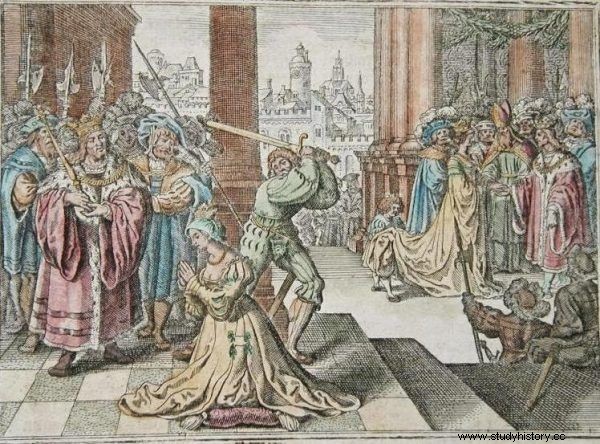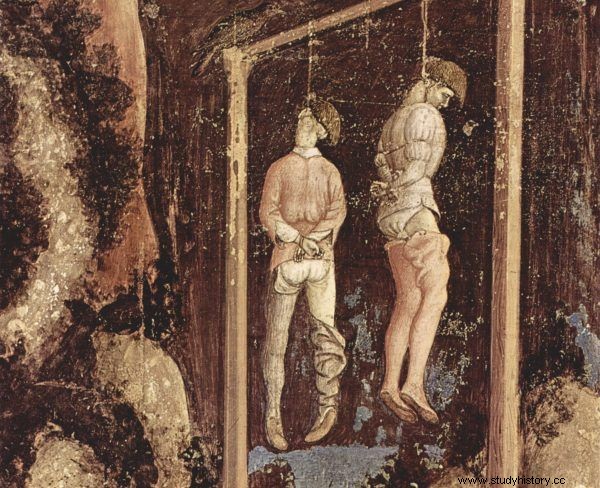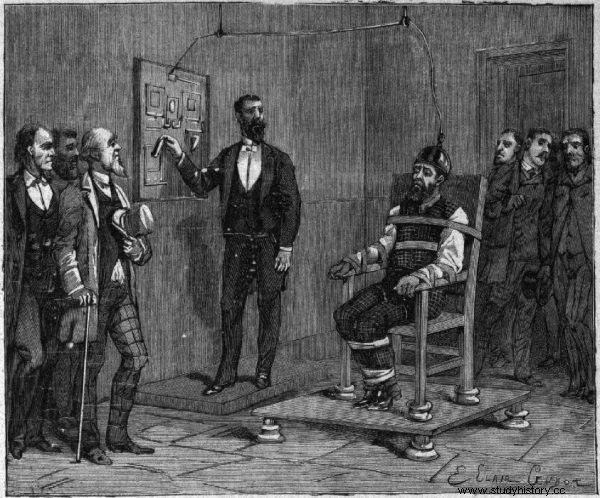It might seem that there is nothing easier than carrying out the death penalty. Tying a rope, grabbing an ax in the hand, or giving a lethal injection shouldn't be that hard. But is it really?
There were so many ineptly executed death sentences that the special term "botched executions" was coined for them - bunched executions. Their common feature? The convicted person is suffering longer or more than necessary.
Nobody says that going to the scaffold should be easy and fun, but humanitarianism requires that dying should be as short as possible and not cause additional suffering. And although many will say, "what the hell, he deserved!", some cases of inept executions really make him sick .
Shorten their heads!
The death sentence by decapitation could be carried out in various ways depending on the times and circumstances. The guilty (or wrongly accused) lost their heads under axes, as a result of being cut with a sword or under a guillotine. It wasn't always a quick death though . Much depended on the efficiency of the executioner or the condition in which the particular tool was used. Do you remember the death of Anna Boleyn and how Henry VIII brought her the best executioner in France? In this way, he just spared her extra suffering.

Henry VIII was perhaps not the best husband, but at least he made sure that his second wife, Anna Boleyn, had a quick and painless death.
In medieval Europe, execution with a sword was reserved for representatives of high society. In the Renaissance, even less-born people could "count" on her. A skilled executioner could behead a condemned man in one fell swoop, even when he was standing. However, if the master of ceremonies had a bad day or was simply not a specialist in his profession, things could have gone much worse ...
In 1699, Angelique Tiquet was sentenced to death for killing her husband. The Parisian woman was about to be beheaded when it started raining. What is delayed is not lost. After half an hour of waiting, the executioner finally got down to work, but at this point the woman turned her head to ask him to try not to disfigure her. It caused the man to miss and cut the side of her neck; then he made another missed attempt. He only killed the woman with the third blow. And that's still nothing. It is said that in 1626 it took as many as 29 blows of the sword for Count de Chalais to die. It's hard to imagine what such an execution must have looked like.
Johnatan J. Moore, in his book "Hang, Gibber, and Dismember" describes the case of an executioner in 1641, who botched his work so much that he barely escaped alive. The crowd was furious with his incompetence and almost lynched him . The convict at the time was the young and apparently exceptionally beautiful Margaretha Voglin, a child-killer with no criminal past, who committed a crime (like many women of that time) to save her honor.
When it came down to it, the executioner swung and ... hit the back of the chair, only injuring Margaret. She fell to her knees, begging for her life to be spared, but there was no escaping the sentence. Meanwhile, attempt number two also proved unsuccessful - the nervous exhausted woman only lost a piece of skin on her neck. The laments and fury of the crowd were of no avail. The torturer decided that up to three times the play and this time he called an assistant to hold the condemned man. In the end, he literally saw off her head, and if he hadn't escaped from the crowd, he would have certainly ended up miserably.
More about how the death penalty was carried out over the centuries in the book:"Hang, gut and dismember, or the history of an execution":
What is to hang…
What could have gone wrong with the execution by hanging? A lot! First of all, the executioner may have used the wrong length of rope. When it was too short, death did not come quickly enough, when too long - the condemned person often ended up headless, because it was torn under his weight (This is what ended up with "Black Jack" Ketchum, who deliberately gained weight before his execution, which his torturer missed and did not adjust the rope to the weight of the criminal).
It also happened that the rope was so long that the condemned person… touched the ground with his feet! There was no question of a quick death then. The executioner and his assistants (and sometimes the volunteers from the crowd) had to hang from the legs of the would-be victim for the victim to suffocate. However, there were cases even more spectacular. Jonathan Moore describes such a situation:
Kat John Thrift botched the execution of Thomas Reynolds in 1736 by cutting him off the gallows too early. Even though Reynolds seemed already dead, he suddenly sat down as he was put in the coffin .
Thrift dragged the condemned man back to the scaffold, but the crowd went mad with rage - the rule that you can't convict someone twice for the same thing is very old. The criminals were not hanged a second time, but died anyway as a result of their injuries.

It's not that easy to hang someone, as many executioners and convicts have learned painfully.
The back is burnt "like a rare steak"
Though Thomas Edison himself worked on the development of the first electric chairs, they were by no means ideal tools. The electrocuted victims did not die immediately, sometimes the action had to be repeated several times.
The worst scenes, and hence suffering, occurred when a convict suffered severe burns before his death his body was starting to burn and his eyes were pouring out of his sockets . In such a situation, one can speak of terrible torture that resulted in death rather than a quick execution of the sentence.
The unfortunate one who was first killed in this way was William Kemmler. He was sentenced to death for splitting the head of a concubine. The man was prepared for the "surgery" and then brought into the room, where not only the tool of his death waited, but also a group of witnesses, including journalists. All of them, when they left the room, had their clothes soaked with the stench of burnt flesh. How did this come about?
When the operator of the machine ran 1000 volts straight into Kemmler's head, the condemned man just started to fry . Nobody knew how long the first execution of this type should take, so it was a bit of a learning from mistakes. The current was turned off after 17 seconds and the goal seemed to be achieved. Then the doctors saw that the man was still breathing. Purple foam was dripping from his lips, he spat. Finally he let out a terrifying groan and his body began to tremble.
But that was not the end of Kemmler's suffering. By the time the electrodes were reconnected (it took about two minutes), the wet sponge, which was responsible for the current conductivity, had dried. For this reason, when the device was turned on again, the condemned man's hair and scalp began to burn. It was too much and for him (he finally died) and the people in the room - some of them passed out.

The first man killed in the electric chair was William Kemmler.
Jonathan J. Moore in his book describes what the body looked like after this extremely unsuccessful execution. Kemmler had purple spots on his face and arms. His brain turned to a charred lump, his back was burned, and his back muscles were literally burned. The pathologist conducting the autopsy compared them to… a well done steak . One can only guess how much the condemned man suffered before he finally died.
(Un) gracious death injection
Ever since the first death penalty was carried out by injection in 1982, it has been the dominant method of killing inmates in the US - possibly because of the illusion that nothing can go wrong here.
The first step is to administer barbiturates to put the guilty party to sleep so that he doesn't know what happens to him later. Then the muscle relaxant comes in to quickly immobilize the lungs and prevent breathing. Finally, potassium chloride is administered to stop the heart beating in the diastolic phase. So much for the theory. History shows that it wasn't always that perfect.
It happened that executions carried out in this way lasted nearly two hours, and the long-lasting torture of the criminal was not uncommon. Ángel Nieves Díaz, convicted of killing a strip club owner half an hour after the anesthetic was administered, was still conscious. The second dose also did not help, so as the measures to kill the condemned man began to circulate in his veins, the condemned man died for 24 minutes, twisting his face in agony. It was over an hour before he finally gave up his ghost.

Why has this happened? Prison staff believed the drugs had not worked properly due to Díaz's liver damage. It turned out, however, that everything was fine with the organ - punctures were badly performed . The barbiturates did not go into the veins, but into the soft tissue. There were severe burns on the left and right arm; dead tissue was departing from healthy tissue.
The wrong administration of the lethal substance not only made it, instead of being diluted in the bloodstream, destroy the convict's body (which in itself caused him great pain), but also caused that it did not work as it should. So when the drug paralyzed the muscles and lungs was administered, the man was still conscious. As we read in "Hang, gut, dismember":
The inmate was aware throughout the procedure. (…) The swelling around his neck showed that Diaz was trying to gasp for air. (...) was probably quite conscious and in excruciating pain when pancuronium (a remedy for muscle relaxation, note by Z.P.) slowly suffocated him and turned off his body functions.
Interestingly, the execution of one of the most famous serial killers, who disguised as a clown, was also "botched" by means of a death injection and thus lured his innocent victims. John Wayne Gacy was executed on May 10, 1994. Due to the ineptitude of inexperienced personnel, the administered substances became concentrated and it took 10 minutes to remove the blockage. It is estimated that in the years 1890–2010 in the United States alone as much as 3% of executions were unsuccessful. How many more - guilty and wrongly accused - people had to suffer? We probably won't find out.
More about how the death penalty was carried out over the centuries in the book:"Hang, gut and dismember, or the history of an execution":
